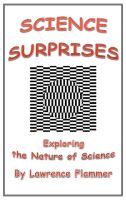Science Surprises: Exploring the Nature of Science by Lawrence Flammer
>> Sunday, August 10, 2014

With an MS in zoology, I taught high school biology for 38 years, "retired" in 1997. I also taught earth science, physical science, life science and computer programming. In 1998, I developed a website for the ENSI program (Evolution and Nature of Science Institute). The site provides classroom-tested interactive lessons on the nature of science and evolution (including geological age dating). These lessons are freely available for download. The site continues to be very popular, with upwards of 2,000 hits per month, and more than 600 teachers on the ENSI listserves. Its lessons are used in many undergraduate classes and increasingly in AP Biology classes. The textbook "Science Surprises" evolved out of a text supplement I developed for teaching the nature of science in the 1960s. I have also enjoyed mentoring new science teachers, both directly and online (with the eMSS program out of UC Santa Cruz New Teacher Center).
I have published a few articles on teaching evolution and the nature of science:
“The Evolution Solution” in the ABT's American Biology Teacher in March, 2006. You can access it easily at http://www.indiana.edu/~ensiweb/evo-solution.html . The article details the approach to teaching evolution that I used for most of my teaching years.
"Chromosome Connections: Compelling Clues to Common Ancestry" in the ABT's American Biology Teacher in February, 2013, available at http://www.indiana.edu/~ensiweb/ABT.ChromConn.2013.pdf . Using tangible features of chromosomes to reveal different lines of evidence of human ancestry.
"Patterns in Time" in NSTA's Science Scope in February, 2011, available at
http://www.indiana.edu/~ensiweb/pat.time.article.pdf . Engaging lessons for developing a personal time sense for deep time, and the patterns of emergence for the major classes of vertebrates over tens of millions of years.
Price: $3.99 USD
First 20% Sample: epub | mobi (Kindle) | lrf




0 comments:
Post a Comment